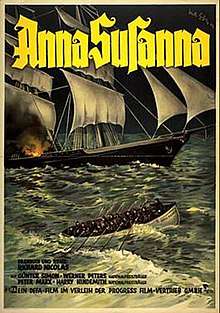Anna Susanna
Anna Susanna is an East German drama film directed by Richard Nicolas. It was released in 1953.
| Anna Susanna | |
|---|---|
 | |
| Directed by | Richard Nicolas |
| Produced by | Adolf Hannemann |
| Written by | Richard Nicolas |
| Starring | Günther Simon |
| Music by | Horst Hanns Sieber |
| Cinematography | Emil Schünemann, Wolf Göthe |
| Edited by | Lieselotte Johl |
Production company | |
| Distributed by | Progress Film |
Release date |
|
Running time | 92 minutes |
| Country | East Germany |
| Language | German |
Plot
During the Great Depression, a rich businessman named Brinkmann decides sink his ship, Anna Susanna, so he would be compensated by the insurance. He orders its captain, Kleiers, to sabotage it while at sea. When Kleiers carries out his instructions, several sailors and passengers notice him. In a fight that ensues, the captain is killed, but not before he manage to shipwreck Anna Susanna. Only a handful of people survive the incident. After they return home, they discover that Brinkmann's insurance fraud worked and he was compensated. They sue him at court and manage to have him indicted.
Cast
- Günther Simon as Orje
- Peter Marx as Fietje
- Werner Peters as Kuddel
- Harry Hindemith as Emil
- Herbert Richter as Kleiers
- Alfred Maack as Peer Frensen
- Maly Delschaft as Kuddel's mother
- Aribert Grimmer as Kuddel's father
- Arno Paulsen as Jan Brödel
- Werner Pledath as Brinkmann
- Fritz Wagner as Uwe Frahm
- Hans Olaf Moser as Wesener
- Klaus Dirks as Lütt Heini
- Lothar Firmans as Van Diemen
- Jürgen Grundling as Jochen-Jürgen
- Friedrich Kühne as Kröger
Production
During 1952, as the government control over DEFA tightened, the studio produced only six films, all of them influenced by the Cold War and dedicated to the ideological struggle between capitalism and socialism. Anna Susanna was one of those.[1] Although the film had a plot suiting the government's policy, the DEFA Board was very reluctant to allow Richard Nicolas, for whom the picture was his debut as a director, to make Anna Susanna. Nicolas had threatened to resign if he would not be allowed to direct it, and was eventually granted permission.[2] The film was also noted for being one of the first DEFA pictures to employ primitive special effects, such as building a miniature ship model that was wrecked in an aquarium.[3]
Reception
Heinz Kersten quoted an East German official who told that "the times in which pictures like Anna Susanna, that damaged the image of DEFA in the eyes of the people... should not return."[4] The West German Catholic Film Service described it as "rather well-developed, thrilling crime film... but filled with typical criticism of the capitalist system."[5]
References
- Sylvia Klötzer. Satire und Macht: Film, Zeitung, Kabarett in der DDR. Böhlau Verlag (2005). ISBN 978-3-412-15005-1. Page 28.
- Ralf Schenk. Das zweite Leben der Filmstadt Babelsberg. DEFA- Spielfilme 1946–1992. ISBN 978-3-89487-175-8. Page 67.
- Werner Reff, István Vásárhelyi. Der Filmtrick und der Trickfilm. Fotokinoverlag VEB (1963). ASIN B0000BT6IC. Pages 21–22.
- Heinz Kersten. Das Filmwesen in der Sowjetischen Besatzungszone Deutschlands. Bundesministerium für Gesamtdeutsche Fragen (1963). ASIN B0000BK48Q. page 38.
- Anna Susanna on the German Film Lexicon.
External links
- Anna Susanna on IMDb
- Anna Susanna original poster on ostfilm.de.
- Anna Susanna on cinema.de.
- Anna Susanna on DEFA Foundation's website.
- Anna Susanna on PROGRESS' website.